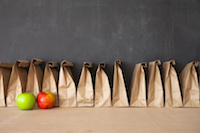 School lunches. They have become a hot topic of debate recently. Are our children going to school with not enough, too much or the wrong sort?
School lunches. They have become a hot topic of debate recently. Are our children going to school with not enough, too much or the wrong sort?
For parents who take the time to make their little darlings a lunch to take in the morning, there is no doubt it is a labour of love. Whether it is a quick peanut butter sandwich, leftovers from last night or a freshly prepared dish, lunches have never been so controversial.
Food fads come and go. It wasn’t that long ago that everyone dropped all fat from their diet and firmly believe that they were doing so in the best interests of their health and waistline.
Today, sugar and refined carbohydrates are the devil, and some dieticians are frowning upon children taking a sandwich to school for lunch.
Common sense has never lead us too far astray, yet when it comes to nutrition, common sense seems to be being left by the wayside in favour of fads and extremism. Yes, we have far too many New Zealanders who are overweight or obese, both children and adults. However, no one food group is entirely responsible. You cannot out-diet a sedentary lifestyle, nor can you out-exercise a poor diet. Balance is the key.
As parents and grandparents, we are responsible for our children’s health, and that includes their weight. The associated health risks of being overweight are well documented – increased risk of type II diabetes and heart disease being the most common. We are the ones who do the shopping, and most of the food preparation, therefore we ultimately have their health in our hands.
Children who are a healthy weight and are active (most schools have a daily fitness programme to complement team sport and general childhood activity) should be able to eat a diet that includes a good variety – plenty of fresh fruit and vegetables, good quality protein and moderate servings of carbohydrates such as bread, rice and pasta.
If you can see your child is becoming overweight, don’t ignore it. Introduce more activity into the household, including walks after dinner or family games of touch or soccer. Limit screen time and encourage outdoor play. Remove temptations from the pantry and replace them with highly nutritious alternatives. Seek advice from your GP or other health professional.
It is our job to have a variety of good quality food on hand for each meal for our children. It is our job to guide them to make good nutritional choices. Sometimes we must insist, rather than giving into the pressure applied by our children based on what they want to eat. Remember children are bombarded with messages about food, but parents are still the major influence when it comes to nutrition.
It is a good idea to limit foods that are high in processed ingredients and low in nutritional value, such as chips and soft drink. However, as adults, we must work hard not to project our adult food hangups onto children. Adults are not as active as children as a general rule, and we are not growing, so our nutritional requirements are different.
So, back to the subject of lunches. The sandwich has been a staple of the modern lunchbox because it is transportable and keeps well. Remember, even in a cooler bag, most food will be room temperature after a few hours, particularly in the summer months. Not all food (chicken for example) is ideal under these conditions.
Vegetarian sushi is another easy option for lunch. Fruit and vegetables, chopped into bite sized pieces are required at most schools for ‘brain snack.’ Raw nuts and small amounts of dried fruit are easy for children to eat and offer good quality energy.
Explain to your child what is going into their lunchbox and why; fruit and vegetables to keep you healthy, and sandwich for energy, a boiled egg or nuts to help you grow, yoghurt for healthy bones etc, so that they understand what they are eating. Save the chips and sweets for birthday parties.
Let's just be sensible about food.









Join the Discussion
Type out your comment here:
You must be logged in to post a comment.